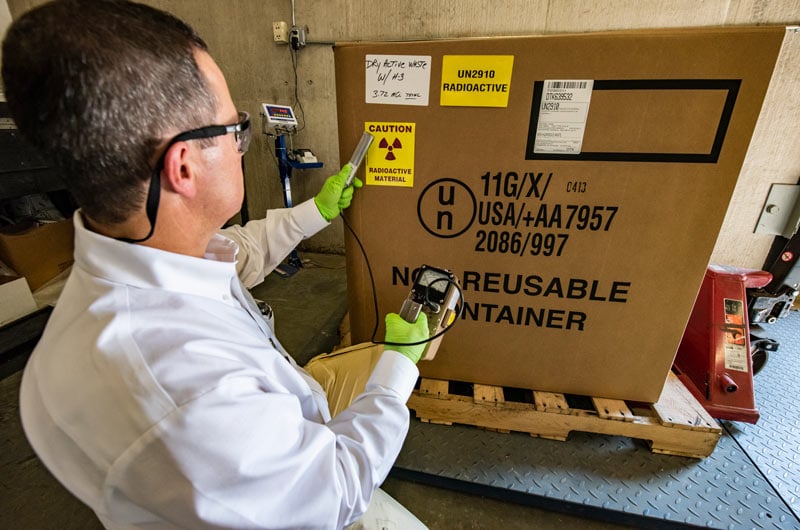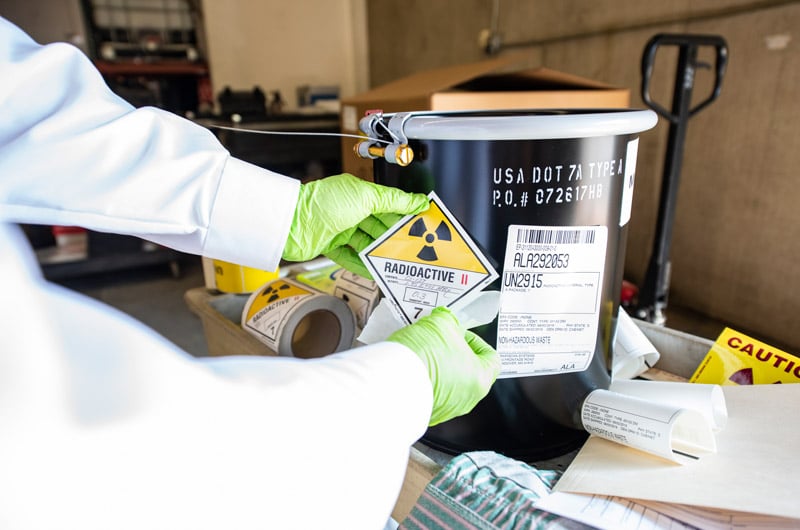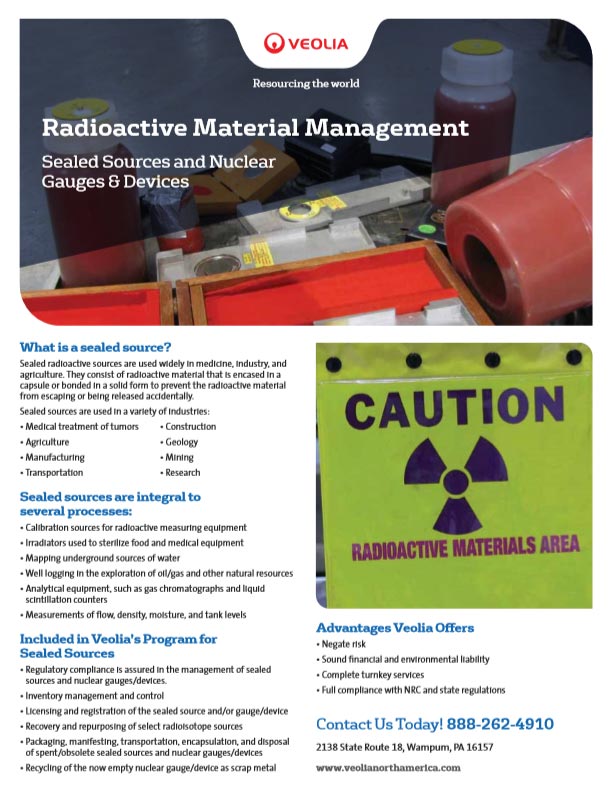It may come as a surprise to learn that every day we are exposed to radiation. Radioactive or nuclear material is used in cancer diagnosis and treatment, preventing infection or killing microbes, carbon dating, geologic dating, and to generate energy.
Thousands of radioactive isotopes are man-made, coming from reactors, cyclotrons and accelerators, and dozens of radioactive isotopes exist naturally in our environment. When we gather information and become more knowledgeable on these radioactive materials, they become more identifiable and manageable.
What is Low-Level Radioactive Waste?
Certain radioactive material and waste can be potentially hazardous to humans, so it is highly regulated by federal and state government agencies. This waste is contaminated with radioactive materials and is generally described as low-level radioactive waste (LLRW). This LLRW must be properly managed to safeguard human health and the environment.
Some examples of the various types of LLRW include:
- Sealed radioactive sources – from various instrumentation, gauges, and other detection devices; such as check sources, depth, flow, and density gauges
- Dry active waste (DAW) – gloves, rags, wipes, clothing, glassware, plastic ware
- Contaminated equipment – duct work, lab hoods, carts, pumps, etc.
- Liquid – aqueous- and/or organic-based, containerized and bulk quantities
- Scintillation vials – organic or aqueous-based, in either glass or plastic
- Mixed waste – LLRW that is also Resource Conservation and Recovery Act (RCRA) or state-mandated to be managed as a hazardous waste
- LLRW infectious and/or biological waste – may include animal carcasses, animal bedding, blood, etc.
- Naturally Occurring Radioactive Materials (NORM) - Natural sources of radioactive elements
- Technically Enhanced Naturally Occurring Radioactive Materials (TENORM) – Extraction and processing of natural radioactive elements

Industries that Create LLRW
Generators of LLRW come from a variety of industries: pharmaceutical, oil & gas, mining, colleges and universities, radioactive isotope manufacturers, commercial nuclear power plants, and research reactors.
All generators of LLRW are required by either the Nuclear Regulatory Commission (NRC) or their individual state governments to correctly manage the waste. The proper management typically involves many steps, including assessment, planning, and implementation of a plan.
How LLRW is Managed
Managing LLRW begins with an assessment or a description of the waste that includes quantities, form, isotopes involved, locations, etc. After the assessment, a plan must be put together for the protection of employees, workers, visitors, and the general public. This involves developing a waste transportation and treatment and disposal plan that identifies a licensed transporter and a permitted disposal facility that can collect, isolate and secure the LLRW. In addition, proper documentation of the waste from cradle to grave is essential to comply with federal and local government agencies.
Before implementation, employees must be properly trained in order to perform the plan adequately and ensure compliance with regulatory agencies.
Some generators of low-level radioactive waste are large and sophisticated enough to carry out the proper management of LLRW by using their own in-house resources. They have the ability to assess, develop, and implement a proper plan internally. However, for many LLRW generators, internal management of the waste is not possible because they do not have the necessary resources. They must rely upon a business partner to provide all or some of the tasks associated with their plan.
Proper Treatment of LLRW
Managing LLRW can be a challenging task due to federal agency compliance requirements, as well as local government regulations, that can vary from state to state. For this reason, a responsible waste generator must undertake a well-conceived due diligence process in selecting their business partner.
A qualified service provider should be experienced and knowledgeable about the complexities of LLRW. Their radiation workers, shippers, and radiation safety workers should hold the necessary certifications to ship and handle radioactive waste in compliance.
When choosing a provider, it is not only important to look at who is nearby the generator, but also the financial strength of the provider and security against legal liability. A trusted and experienced service provider can both provide longevity of service and also offer additional services, such as training, documentation control, and consulting or advising, especially with issues related to radiation safety.

Disposal of LLRW in the U.S.
The disposal of commercial LLRW in the United States is generally defined as the placement of the waste into a landfill cell within a licensed and permitted facility. The facility must be designed, constructed, and operated to meet very specific safety standards. The placement of the LLRW into the landfill cell must be performed to ensure that the radioactive waste is immobilized and will not be released into the environment. Currently, there are only four sites where this procedure can be followed.
The treatment and processing of LLRW is a precursor step before the actual disposal of the waste. Examples of treatment and processing include:
- Volume reduction – compaction/supercompaction; cutting or sizing to reduce void space; repackaging from larger to smaller containers
- Evaporation – removal of water from the LLRW and capturing the radioactive material via scrubbers and filters, or solid residues left behind
- Consolidation – repackaging of similar types of waste for economies of scale advantages
- Incineration/thermal – high temperature treatment to physically change organic solids/liquids to a gas or vapor. The radioactive material is captured via scrubbers and filters or contained in the ash
- Decontamination – the removal of radioactive contamination from surface area objects and then concentrating the radioactive contamination into a smaller volume. This also applies to the removal of contamination from heavy, dense objects onto lighter, less dense objects
Upon completion of the various treatment or processing techniques, the waste is then transferred to one of the commercial available LLRW disposal sites.
Mitigating the Complexity of LLRW
Radioactive material is abundant in the environment, as well as in man-made sources, and can benefit society in many different ways. The issue lies in how LLRW is treated and disposed after it is created so that it is properly and safely managed within regulations. When radioactive waste is created, it can be regulated by several federal and state government agencies, so it is imperative to find the proper waste management company to ensure your business stays in compliance. When the generator of the waste adequately researches the provider to handle their waste, the complexity of having to deal with LLRW can be managed effectively.



